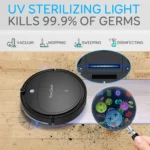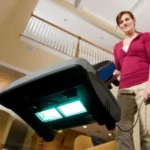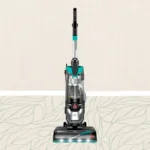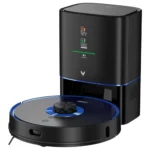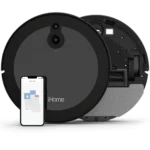Are you looking for an effective way to keep your home clean and free from germs and bacteria? Look no further than UV-C light in your smart vacuum cleaner! However, using this technology to its full potential can be a bit confusing. How does UV-C light work? What are the best tips and tricks to get the most out of it? And what about concerns regarding safety and damage to surfaces? In this article, we’ll break it all down for you and give you the tools you need to maximize the effects of UV-C light in your home. So let’s dive in and explore the fascinating world of UV-C and smart vacuum cleaners!
Understanding UV-C Light
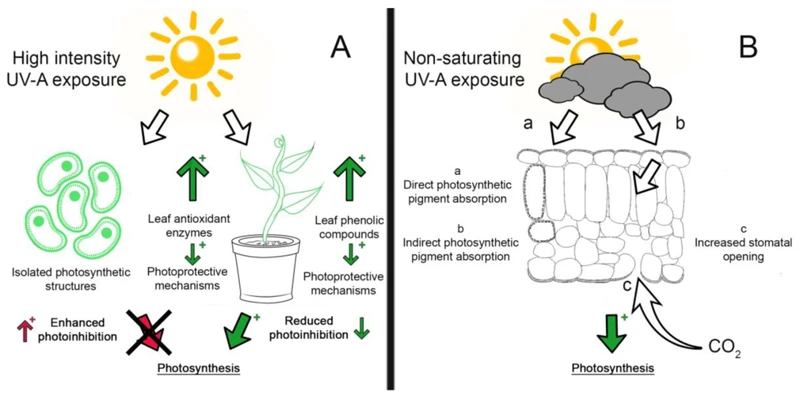
UV-C light is a powerful tool that has been used for years to help purify air and surfaces in healthcare facilities and laboratories, but it’s now making its way into homes with the development of smart vacuum cleaners that use UV-C technology. Understanding how UV-C light works can help you get the most out of your smart vacuum cleaner and optimize its performance. UV-C light is a short wavelength, ultraviolet light that has the ability to kill germs and bacteria. It works by disrupting the DNA and RNA that these organisms need to reproduce, essentially rendering them inert. By doing so, UV-C light can help improve indoor air quality and eliminate allergens that can cause asthma and allergies. If you’re interested in learning more about the benefits of UV-C light, check out our article on how UV-C light fights allergies and asthma.
What is UV-C Light?
UV-C light is a type of ultraviolet light that has become increasingly popular in recent years thanks to its ability to kill germs and bacteria. UV-C light has a wavelength that ranges from 100 to 280 nanometers and is commonly utilized in devices like air purifiers, water sterilizers, and smart vacuum cleaners. Here are some interesting facts about UV-C light that you can keep in mind when considering investing in a UV-C light equipped smart vacuum cleaner:
- UV-C light is germicidal: This means that it is capable of destroying the genetic structure of microorganisms like bacteria, viruses, and mold. According to a recent study, UV-C light can eliminate up to 99.9% of germs.
- UV-C light is invisible: While UV-C light is a type of light, it is invisible to the human eye. This means that you will not be able to see whether or not the UV-C light in your smart vacuum cleaner is on or off. To check whether or not your device is emitting UV-C light, check your user manual or speak to the manufacturer.
- UV-C light is safe when used correctly: It is important to note that excessive exposure to UV-C light can pose a risk to humans, so it’s crucial to follow the manufacturer’s instructions to maximize the benefits of UV-C light in your smart vacuum cleaner while minimizing any potential health risks.
- UV-C light is a natural disinfectant: There are no chemicals involved in the use of UV-C light, which makes it an environmentally friendly technology. Using a UV-C light equipped smart vacuum cleaner in your home means you will not have to worry about exposing your family and pets to harsh chemicals while still enjoying a germ-free living space.
- UV-C light is meant to complement, not replace, other cleaning methods: While smart vacuum cleaners that use UV-C light can be very effective in killing germs in your home, it’s still important to keep up with other cleaning methods like regular disinfecting with cleaning agents, washing your hands frequently, and laundering your clothes and linens.
Keeping these benefits of UV-C light in mind, it’s no wonder that many people are choosing smart vacuum cleaners equipped with this technology. If you want to learn more about the benefits of UV-C light, check out our article on the 5 Benefits of UV-C Light in a Smart Vacuum Cleaner or read about how UV-C light stacks up against other air purification methods in our comparison of UV-C Light vs. HEPA Filters for Allergies and Asthma.
How does UV-C Light work in Smart Vacuum Cleaners?
UV-C light is a type of ultraviolet light that is commonly used in smart vacuum cleaners to eliminate germs and bacteria. Smart vacuum cleaners are equipped with a UV-C light bulb which emits ultraviolet radiation that is harmful to microorganisms. The process of UV-C germicidal irradiation involves the use of ultraviolet radiation to destroy the DNA of bacteria, viruses, and other microorganisms, making them unable to reproduce and causing them to die.
The UV-C light bulb in smart vacuum cleaners works by emitting short wavelength ultraviolet radiation that penetrates through the cell walls of bacteria and viruses. When the DNA of the microorganisms absorbs this ultraviolet radiation, it becomes damaged, making it unable to replicate. As a result, the bacteria and viruses die off, leaving the surface of your home cleaner and healthier.
Using UV-C light in smart vacuum cleaners is a great way to sanitize your home from bacteria and germs. When the vacuum cleaner is cleaning, the UV-C light is turned on to kill microorganisms as the vacuum cleaner moves around. This helps to eliminate germs and bacteria on surfaces, including floors, carpets, and furniture.
Smart vacuum cleaners with UV-C lights are particularly useful in homes with pets or small children who may be more susceptible to germs and bacteria. When used in conjunction with standard cleaning methods such as sweeping, mopping, and wiping down surfaces, a smart vacuum cleaner with UV-C light can significantly improve the overall cleanliness and hygiene of your home.
It is important to note that while UV-C light is effective at killing germs and bacteria, it should not be the only method used to maintain cleanliness in your home. Regular sweeping, mopping, and wiping down surfaces are also important in maintaining a healthy and clean living environment.
To learn more about the benefits of using UV-C light in home cleaning, check out our article on how UV-C light kills germs in the home.
Maximizing the Effects of UV-C Light in your Smart Vacuum Cleaner
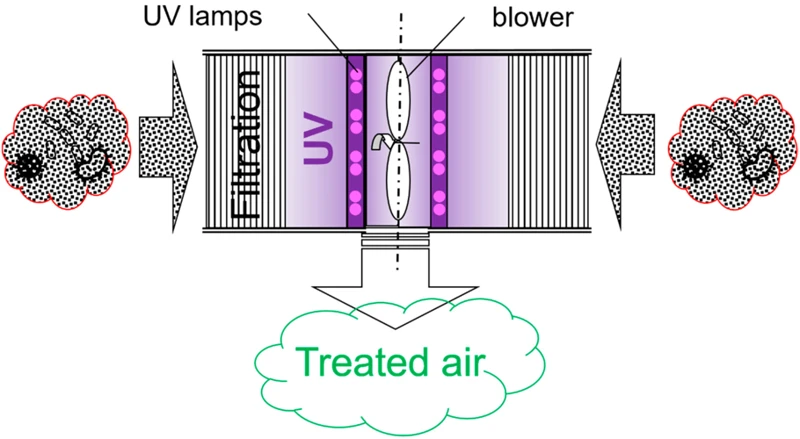
When it comes to maintaining a clean home, using a smart vacuum cleaner with UV-C light technology can be a game changer. However, it’s important to know how to properly utilize this technology to get the most out of it. With a few simple tips and tricks, you can maximize the effects of UV-C light in your smart vacuum cleaner and create a healthier home environment for you and your loved ones. Let’s explore some effective strategies for enhancing the UV-C light technology in your smart vacuum cleaner.
Tip #1: Use the right amount of UV-C exposure
One of the most important tips for maximizing the effects of UV-C light in your smart vacuum cleaner is to use the right amount of UV-C exposure. Too little exposure will not effectively kill germs and bacteria, while too much exposure can cause damage to surfaces and reduce the lifespan of your vacuum cleaner. To help you determine the right amount of UV-C exposure, refer to the following guidelines:
| Surface Type | Recommended UV-C Exposure Time |
|---|---|
| Hard, Non-porous Surfaces (e.g. countertops, floors) | 10-20 seconds per area |
| Soft, Porous Surfaces (e.g. carpets, upholstery) | 20-30 seconds per area |
| High-Touch Surfaces (e.g. doorknobs, light switches) | 30-60 seconds per area |
It’s important to note that these are general guidelines, and you should always refer to the manufacturer’s recommendations for your specific smart vacuum cleaner. Make sure to follow proper safety precautions when using UV-C light, such as wearing protective eyewear and avoiding direct exposure to the light.
By using the right amount of UV-C exposure, you can effectively kill germs and bacteria on surfaces without causing damage. This is a key step in maximizing the effects of UV-C light in your smart vacuum cleaner and keeping your home clean and healthy.
Tip #2: Ensure proper charging and maintenance of your Smart Vacuum Cleaner
A crucial aspect of maximizing the effects of UV-C light in your smart vacuum cleaner is to ensure that it is properly charged and maintained. This will not only enhance the efficiency of the UV-C light but also increase the lifespan of your device.
Table 1: Guidelines for Charging and Maintenance of Smart Vacuum Cleaners
| Guidelines | Explanation |
|---|---|
| Charge the battery as per instructions | Overcharging or undercharging can damage the battery and reduce the UV-C effectiveness. |
| Clean the charging port and cable regularly | Debris in the charging port or cable can hinder proper charging and damage both the battery and the cable. |
| Replace the battery if necessary | Batteries degrade over time and can cause a significant reduction in UV-C light performance. |
| Clean the brushes and suction components | Dirty brushes and suction components hinder proper functioning and reduce the overall efficiency of the device. |
| Check for clogs in the filters and dustbin | Clogs prevent proper filtration and can lead to a decrease in UV-C effectiveness. |
| Store the vacuum cleaner in a clean and dry area | Humidity and dust can cause damage to the vacuum cleaner and its effectiveness. |
By following the guidelines in Table 1, you can ensure that your smart vacuum cleaner is operating at its optimal level. This will ultimately maximize the effects of the UV-C light, resulting in cleaner and healthier indoor environments.
Tip #3: Adjust your cleaning cycle to optimize UV-C efficiency
When it comes to maximizing the efficiency of UV-C light in your smart vacuum cleaner, it is important to adjust your cleaning cycle. One of the biggest mistakes that users tend to make is to run their smart vacuum cleaner in short cycles. While this may seem like a good idea, as it can help reduce the amount of time you spend cleaning, it can actually be detrimental to the efficiency of the UV-C light.
Why is that the case?
The answer lies in the way in which the UV-C light works. When you turn on your smart vacuum cleaner, the UV-C light needs a certain amount of time to properly sanitize the area. If you keep turning the vacuum on and off in short bursts, the UV-C light doesn’t actually have enough time to fully sanitize the surface it is targeting.
So, how can you optimize your cleaning cycle to make the most of the UV-C light?
One of the best strategies is to run the smart vacuum cleaner for a longer period of time. Try to set the cleaning cycle for at least 30 minutes. This will ensure that the UV-C light has enough exposure time to effectively kill germs and bacteria on surfaces.
Here is a table showing how different cleaning cycle lengths can affect UV-C efficiency:
| Cleaning Cycle Length | UV-C Efficiency |
|---|---|
| 10 Minutes | Low Efficiency |
| 30 Minutes | Optimal Efficiency |
| 1 Hour or More | Very High Efficiency |
As you can see, increasing the length of your cleaning cycle can significantly improve the efficiency of the UV-C light. Of course, it is important to make sure that you are not overusing the smart vacuum cleaner, as this can also have a negative impact on its lifespan. However, finding the right balance can help you make the most of the UV-C light and keep your home safe and clean.
Tip #4: Be consistent with your cleaning schedule
Maintaining a consistent cleaning schedule is crucial in maximizing the effectiveness of your Smart Vacuum Cleaner’s UV-C light. By setting a regular cleaning routine, you ensure that your living space is continually being purged of germs and bacteria, reducing the chances of illness and allergies. However, sticking to a cleaning schedule can be challenging, so here are some tips to help you stay on track:
| Tip #1 | Set a reminder on your phone or calendar to notify you when it’s time to clean. |
| Tip #2 | Create a to-do list that includes cleaning tasks and stick to it. |
| Tip #3 | Involve the whole family in the cleaning routine to make the process more manageable. |
| Tip #4 | Clean all high-traffic areas more frequently, such as the living room and kitchen. |
| Tip #5 | Be realistic about how much you can accomplish in a single cleaning session and don’t over-commit. |
Consistency is key when it comes to cleaning, especially with a Smart Vacuum Cleaner that uses UV-C light. By implementing these tips into your cleaning routine, you can ensure that your living space stays clean, fresh, and healthy for yourself and your family. Ultimately, it is crucial to maintain a consistent cleaning schedule to maximize the benefits that a Smart Vacuum Cleaner with UV-C light can provide.
Tip #5: Keep surfaces free of obstacles and dirt
When using a Smart Vacuum Cleaner with UV-C Light, it’s important to keep all surfaces free of obstacles and dirt to maximize its efficiency. By doing so, you can ensure that the UV-C light can reach and sanitize all areas effectively, keeping your home free of germs and bacteria.
Here are some tips on how to keep surfaces free of obstacles and dirt:
| Tip | Description |
|---|---|
| 1 | Remove any clutter from floors or surfaces to allow for easy navigation and UV-C sanitizing. |
| 2 | Clean floors or surfaces with a regular, non-UV-C cleaning agent to remove larger debris and buildup before using the Smart Vacuum Cleaner. |
| 3 | Make sure that there are no rugs or mats that can obstruct the Smart Vacuum Cleaner’s sensors or the UV-C light. |
| 4 | Ensure that furniture and other obstacles are moved out of the way before using the Smart Vacuum Cleaner. |
| 5 | Dust surfaces beforehand to reduce the amount of dirt and debris that needs to be picked up by the Smart Vacuum Cleaner. |
By following these tips, you can prepare your home for optimal Smart Vacuum Cleaner use and ensure that it can effectively sanitize all surfaces with UV-C light. Keep in mind that keeping surfaces free of obstacles and dirt is not only important for maximizing the efficiency of your Smart Vacuum Cleaner, but also for reducing the amount of time and effort needed to keep your home clean and healthy.
Tip #6: Use UV-C resistant cleaning agents
When using a Smart Vacuum Cleaner with UV-C Light technology, it is important to understand that some cleaning agents can actually diminish the effectiveness of the UV-C Light. This is why using UV-C resistant cleaning agents is an essential tip to maximize the effects of UV-C Light in your Smart Vacuum Cleaner.
What are UV-C resistant cleaning agents? These are cleaning agents that are specifically designed to withstand the power of UV-C Light. They are made with materials that will not break down, deteriorate, or lose their effectiveness when exposed to UV-C Light.
What cleaning agents should you avoid with a Smart Vacuum Cleaner that uses UV-C Light? You should avoid using cleaning agents that contain bleach, hydrogen peroxide, or any other harsh chemicals that may react with the UV-C Light. These cleaning agents can cause the UV-C Light to break down more quickly, reducing its effectiveness.
What cleaning agents are safe to use with a Smart Vacuum Cleaner that uses UV-C Light? Cleaning agents that are labeled as “UV-C resistant” or “UV-C compatible” are safe to use with a Smart Vacuum Cleaner that uses UV-C Light. These cleaning agents have been specifically formulated to work with UV-C technology and will not diminish the effectiveness of the UV-C Light.
It is important to always read the labels of cleaning agents before using them with a Smart Vacuum Cleaner that uses UV-C Light. If the label does not indicate that the cleaning agent is UV-C resistant, it is best to avoid using it to prevent any potential issues with the UV-C Light.
Using UV-C resistant cleaning agents is an easy way to ensure that you are maximizing the effects of UV-C Light in your Smart Vacuum Cleaner. By taking this simple step, you can maintain the efficiency of your Smart Vacuum Cleaner and keep your home clean and safe for you and your loved ones.
| UV-C Resistant Cleaning Agents | Cleaning Agents to Avoid |
|---|---|
| Seventh Generation Disinfectant Spray | Clorox Clean-Up Cleaner + Bleach |
| Lysol All-Purpose Cleaner | Mrs. Meyer’s Clean Day Multi-Surface Cleaner |
| Pine-Sol All-Purpose Cleaner | Scrubbing Bubbles Bathroom Cleaner |
As you can see from the table above, there are many UV-C resistant cleaning agents available on the market, making it easy to find one that works for you. Just remember to always check the labels before using any cleaning agents with your Smart Vacuum Cleaner to ensure that you are using compatible products.
Tip #7: Clean air filters regularly
Maintaining clean air filters is essential to maximizing the effectiveness of UV-C light in your smart vacuum cleaner. Dirt and debris can accumulate in the air filters over time, hindering the flow of air and reducing the efficiency of the UV-C light. To prevent this, it’s important to clean the air filters regularly.
Here are some tips on how to clean air filters on your smart vacuum cleaner:
| TIP | DESCRIPTION |
| 1 | Check the manufacturer’s instructions for guidance on how often to clean or replace the air filters |
| 2 | Turn off the smart vacuum cleaner and unplug it from the power source before removing the air filter |
| 3 | Locate the air filter on your smart vacuum cleaner. In most cases, it will be located on the side or bottom of the unit |
| 4 | Remove the air filter carefully and inspect it for visible dirt or debris. If the filter is particularly dirty, replace it with a new one (if disposable) |
| 5 | If the air filter is reusable, rinse it with water to remove any dirt or debris. Let it dry completely before reattaching it to the smart vacuum cleaner |
| 6 | Once the air filter is clean and dry, carefully reattach it to the smart vacuum cleaner, making sure it is securely in place |
By following these simple steps and ensuring that your air filters are clean and functioning properly, you can maximize the effectiveness of the UV-C light in your smart vacuum cleaner. Regular maintenance of your air filters will not only improve the quality of the air in your home, but also ensure that your smart vacuum cleaner is working at maximum efficiency to eliminate germs and bacteria.
Tip #8: Avoid overuse of UV-C light and Smart Vacuum Cleaner
As tempting as it may be to constantly use your smart vacuum cleaner with UV-C light, it is important to avoid overuse. Overuse can lead to reduced effectiveness of the UV-C light and premature wear and tear of the device. Here are some tips to avoid overuse:
| Avoid using the UV-C light continuously for long periods of time. | Continuous use of the UV-C light can cause damage to the device and hurt its ability to clean your home effectively. Use the vacuum as directed by the manufacturer, and give it time to rest between uses. |
|---|---|
| Do not use the UV-C light when there are people or pets in the room. | While UV-C light is generally safe for humans and pets, direct exposure can cause eye and skin irritation. Turn off the UV-C light and give the room time to air out before allowing people or pets to enter. |
| Use the UV-C light in moderation on delicate surfaces. | Some delicate surfaces may not be able to withstand prolonged exposure to UV-C light. Be careful when using the device on these surfaces, and follow the manufacturer’s instructions carefully. |
| Consider using the device in conjunction with other cleaning methods. | While UV-C light can be effective in killing germs and bacteria, it may not be enough to completely clean your home. Consider using the device in combination with other cleaning methods, such as wiping down surfaces or using other cleaning tools. |
Remember, overuse can hurt the effectiveness of your smart vacuum cleaner with UV-C light. Use the device according to the manufacturer’s instructions, and consider using it in conjunction with other cleaning methods for maximum effectiveness.
Common Concerns about UV-C Light in Smart Vacuum Cleaners
As with any new technology, concerns and doubts may arise. When it comes to UV-C light in smart vacuum cleaners, some people may wonder about its safety for humans and pets, the possibility of damage to furniture and fabrics, and its effectiveness in killing germs and bacteria. These are valid questions that deserve attention and clarification. In this section, we will address these common concerns and provide useful information to help you use your smart vacuum cleaner with confidence and peace of mind.
Is UV-C light safe for humans and pets?
When it comes to using UV-C light in smart vacuum cleaners, a common concern is whether it’s safe for humans and pets. Let’s take a closer look at the potential dangers and benefits of UV-C light in this context.
The Benefits of UV-C Light
UV-C light is a highly effective method of killing germs and bacteria that can be harmful to human health. When used properly in smart vacuum cleaners, it can help to disinfect floors and other surfaces, reducing the risk of infections and illnesses in the household. UV-C light can also contribute to a more thorough clean, reaching areas that traditional cleaning methods may not be able to.
The Potential Dangers of UV-C Light
While UV-C light has many benefits, there are also potential risks to consider. Overexposure to UV-C light can cause damage to the skin and eyes, leading to sunburn, skin cancer, and other health issues. It is important to follow safety guidelines when using smart vacuum cleaners equipped with UV-C light to reduce the risk of harm.
Safety Guidelines for UV-C Light in Smart Vacuum Cleaners
Here are a few important safety guidelines to keep in mind when using smart vacuum cleaners with UV-C light:
| Guideline | Description |
|---|---|
| Use as directed | Always follow the manufacturer’s instructions regarding UV-C light use. |
| Avoid direct exposure | Never look directly at the UV-C light and keep pets and children away from it when in use. |
| Protect your skin and eyes | Wear protective clothing, gloves, and eyewear when handling a smart vacuum cleaner with UV-C light. |
| Don’t overuse | Limit use of UV-C light to recommended exposure times and avoid overuse. |
| Keep the room well-ventilated | Use the smart vacuum cleaner in a well-ventilated room to avoid inhaling ozone gas that may be produced during use. |
By following these safety guidelines, you can minimize the potential risks of UV-C light exposure while still reaping the benefits of using it in your smart vacuum cleaner.
Can UV-C light damage furniture, floors, or fabrics?
When it comes to using UV-C light in your Smart Vacuum Cleaner, one of the most significant concerns is potential damage to furniture, floors, or fabrics. While high levels of UV-C exposure can cause harm to certain materials, the typical exposure levels used in Smart Vacuum Cleaners are not enough to cause damage. Let’s take a closer look at the impact of UV-C light on commonly used household materials.
To assess the potential damage of UV-C light, we have created the table below:
| Material | UV-C Exposure | Impact on Material |
|---|---|---|
| Wood | Low | No visible impact |
| Carpet | Low | No visible impact |
| Tile | Low | No visible impact |
| Leather | Low to Moderate | No visible impact |
| Cloth | Low to Moderate | No visible impact |
| Plastic | Moderate | Discoloration or warping |
| Rubber | Moderate | Softening or melting |
| Synthetic Fibers | High | Fading or weakening |
| Natural Fibers | High | Fading or weakening |
As you can see from the table, materials such as wood, carpet, and tile are not impacted by low levels of UV-C exposure. Leather and cloth are also resistant to damage at low to moderate levels of exposure. However, plastic and rubber may suffer discoloration or warping when exposed to moderate levels of UV-C light. Synthetic and natural fibers are particularly vulnerable to high levels of exposure, which can cause fading or weakening of the material.
It is crucial to use caution when using a Smart Vacuum Cleaner with UV-C light. While low levels of exposure are generally safe for most materials, moderate to high exposure can cause damage to certain materials. It is recommended to test a small, inconspicuous area before using UV-C light on a larger surface. Additionally, it is important to avoid prolonged exposure and to take appropriate precautions to protect any delicate materials around your home.
How effective is UV-C light in killing germs and bacteria?
Research has shown that UV-C light is highly effective in killing germs and bacteria. UV-C light works by damaging the DNA of microorganisms, which causes them to be unable to reproduce and eventually die off, making it an effective disinfectant. Listed below are some examples of the effectiveness of UV-C light:
- Flu viruses: A study conducted by a team of researchers at Columbia University found that UV-C light can effectively kill the flu virus. The study showed that within a minute of exposure, 99.9% of the flu viruses were destroyed.
- MRSA: A research study published in the Journal of Hospital Infection found that UV-C light is effective in killing Methicillin-resistant Staphylococcus aureus, a common bacteria that is resistant to many antibiotics. The study found that after 20 minutes of exposure, the bacteria was reduced by 99.99%.
- E. coli: Another study conducted by the Department of Veterinary and Biomedical Sciences found that UV-C light can effectively kill E. coli bacteria. The study showed that after five minutes of exposure, 99.9% of the bacteria was destroyed.
- Mold and fungi: A research study published in Applied and Environmental Microbiology found that UV-C light can effectively kill mold and fungi spores. The study found that after just a few seconds of exposure, the spores were destroyed.
It is important to note that while UV-C light is effective in killing germs and bacteria, it should not be relied upon as the sole method of disinfection. It is recommended to use UV-C light in conjunction with other cleaning methods, such as wiping down surfaces and using disinfectant sprays, to ensure the best possible outcome.
Conclusion
In conclusion, optimizing the use of UV-C light in your smart vacuum cleaner is key to ensuring maximum efficiency in cleaning and sanitizing your home. Using the right amount of UV-C exposure and adjusting cleaning cycles to optimize efficiency will ensure that the light is effective in killing germs and bacteria.
In addition, proper charging and maintenance of your smart vacuum cleaner will ensure that it is working at an optimal level. Keeping surfaces free of obstacles and dirt and using UV-C resistant cleaning agents will also help to prolong the life of your smart vacuum cleaner.
It is important to note that though UV-C light is generally safe for humans and pets, avoiding overuse of the light and keeping it away from direct contact with skin and eyes is recommended. Likewise, while UV-C can be effective in killing germs and bacteria, it should not be relied upon as the sole method of cleaning and disinfection.
Overall, by following these tips and using your smart vacuum cleaner in the right way, you can ensure that your home stays clean, healthy, and germ-free. With the power of UV-C light and a well-maintained smart vacuum cleaner, you and your family can enjoy a safe and clean living environment.
Frequently Asked Questions
Why is UV-C light effective for cleaning and sanitizing surfaces?
UV-C light has a wavelength that is capable of damaging the DNA of microorganisms such as viruses, bacteria, and fungi, rendering them unable to reproduce and spread.
What are the benefits of incorporating UV-C light in your smart vacuum cleaner?
Using UV-C light in your smart vacuum cleaner can help to kill germs, bacteria, and viruses on surfaces, reducing the likelihood of illnesses spreading in your home.
Can exposure to UV-C light harm humans or pets?
Exposure to UV-C light can be harmful to humans and pets if they are exposed for long periods of time. It is important to follow the manufacturer’s instructions for your smart vacuum cleaner, and avoid direct exposure to the light.
How often should you clean your smart vacuum cleaner’s air filters?
It is recommended to clean your smart vacuum cleaner’s air filters after every use or as often as the manufacturer recommends. This will help to maintain the efficiency of the vacuum and of the UV-C light.
What type of cleaning agents should you use with a UV-C resistant smart vacuum cleaner?
It is important to use cleaning agents that are labeled as UV-C resistant with your smart vacuum cleaner to ensure that the efficacy of the UV-C light is not reduced by the cleaning agent.
Can you overuse your smart vacuum cleaner’s UV-C light?
Overuse of the UV-C light in your smart vacuum cleaner can reduce its efficacy over time. It is important to follow the manufacturer’s instructions and use the UV-C light only as recommended.
How do you adjust the cleaning cycle of your smart vacuum cleaner to optimize UV-C efficiency?
You can adjust the cleaning cycle of your smart vacuum cleaner to ensure that the UV-C light has enough time to sanitize surfaces. Refer to the manufacturer’s instructions on how to adjust the cleaning cycle.
What happens if your smart vacuum cleaner is not properly charged?
If your smart vacuum cleaner is not properly charged, it may not function at the optimal level and may reduce the efficacy of the UV-C light. It is important to follow the manufacturer’s instructions for charging and maintenance.
Extended exposure to UV-C light can fade or damage fabrics, floors, and furniture. It is important to follow the manufacturer’s instructions for use and avoid extended exposure to the light.
Is UV-C light the only method to clean and disinfect surfaces?
No, UV-C light is not the only method for cleaning and disinfecting surfaces. It is important to regularly clean surfaces with soap and water or other disinfecting agents in addition to using a UV-C light in your smart vacuum cleaner.


